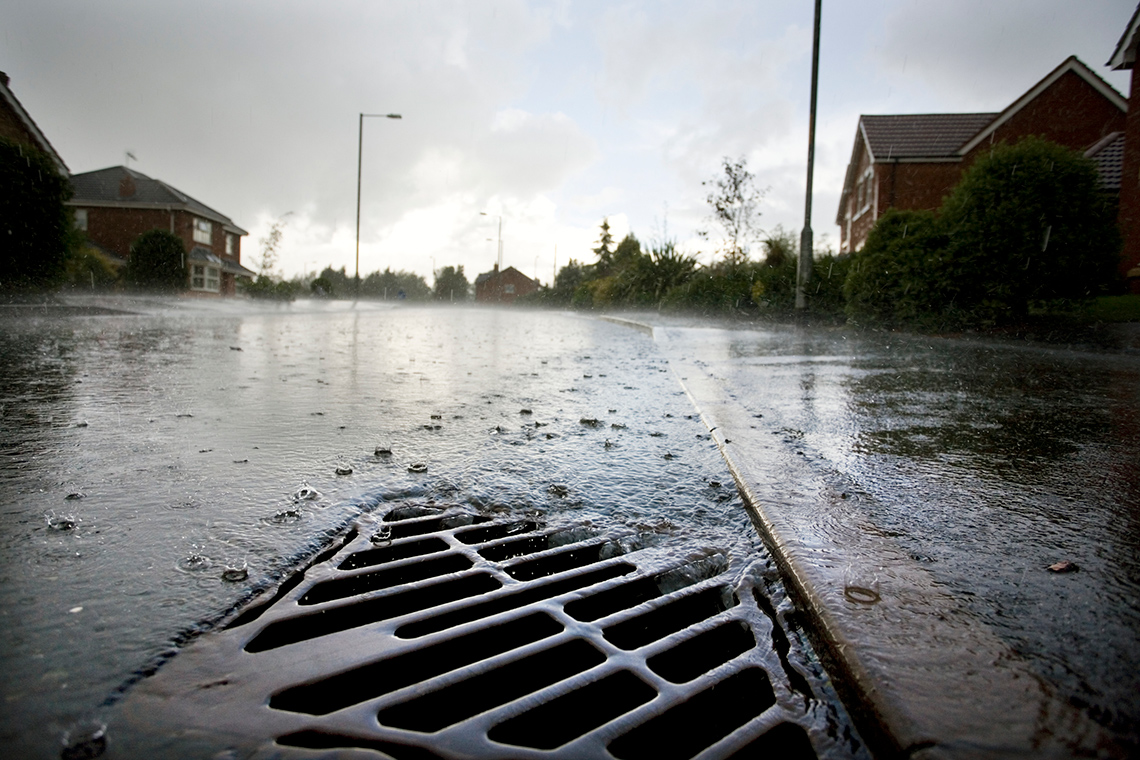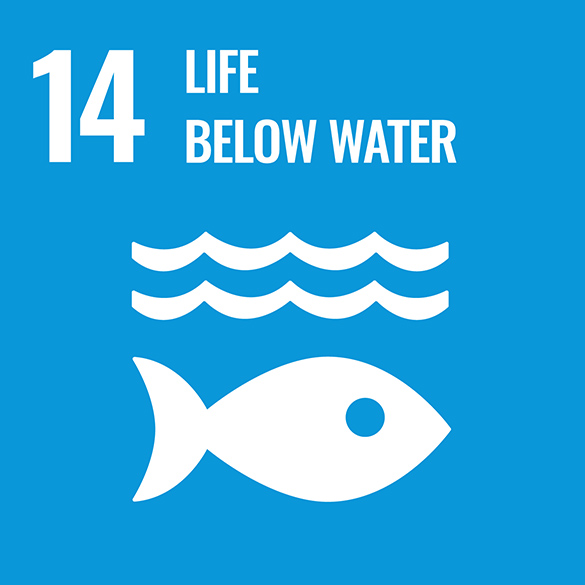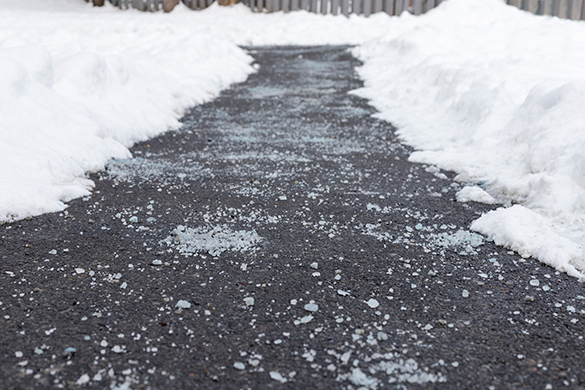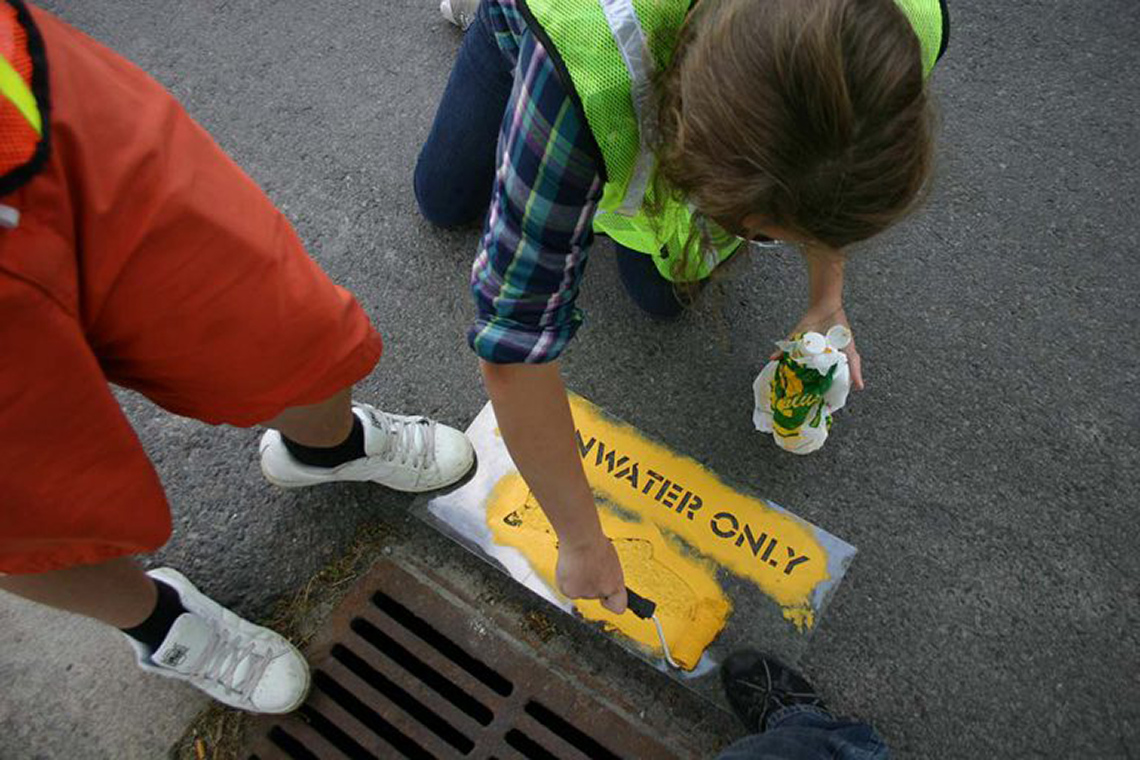Minds On
Follow the ball
Explore the following images and descriptions. As you explore, follow the ball.
Where do you think the ball is going?
Record your ideas on paper, digitally or orally.




Action
Water around the world
Much of our world is made up of water.
Most of that water is found in oceans, lakes, rivers, and streams.
There is also water that starts as rain or snow and ends up in our waterways by flowing into storm drains. The ball from Minds On that you explored went into the storm drain.
Storm drains
Storm drains are the grates found on the side of roads in cities and towns.

The purpose of a storm drain is to take rainwater away from the roads, driveways, sidewalks, and yards so the water does not gather and cause flooding.
What is flooding? Flooding happens when land that is usually dry ends up being underwater. This can happen because of heavy rain if the rainwater has nowhere to go.
The water from the roads, driveways, sidewalks, and yards drains into pipes that are underground. These pipes lead the water into a nearby creek, river, a lake, or even the ocean.
Outside of cities, the rainwater collects in ditches that drain into creeks and rivers.

In the spring when the snow melts, there is a lot of water. This water flows into the storm drains. Sometimes other items that are on the ground also end up flowing into the storm drain. This can be dirt or sand that is on the ground, but it could also be other items that can be harmful to the water. Some examples include:
- road salt (used to melt snow and ice in the winter)
- chemicals that people put on their grass to get rid of weeds
- motor oil, paints, and other common household items
- animal droppings and animal waste
- litter that was on the ground
Pause and Reflect
What happens to items in the water?
How might these items affect the storm drains?
How might these items affect the water?
Record your ideas using a method of your choice.
Connecting to the world

The United Nations (UN) is a group of many countries from around the world that have come together to create a better future for people and the environment. They have created 17 goals called the Sustainable Development Goals.
This learning activity is connected to Goal #14 which is called Life Below Water. This means everyone should help protect our oceans and seas.
Water and land
Water everywhere travels to the ocean eventually. What we do on land, even far from the oceans, affects life in the ocean.
Let’s explore our choices on land, and how they can affect life in the water with the following activity.
Task 1: What do you notice?
Have you noticed any of the following items in your neighbourhood?
Check any items that you notice are in your neighbourhood.
In my neighbourhood, I notice…
All of these items can affect how clean the rainwater is, when it eventually flows into a stream, river, or creek.
Some of the items above act like a sponge and help to absorb or soak up rainwater and any pollutants. When items absorb water, it slows the flow of the water before it gets to waterways. Trees, gardens, and grass all help to absorb and filter water.
Sometimes items end up in our water systems. Some of the items include car oil, spilled paint, and pet waste. They mix with the water and act as pollution.
The water and pollution flow fast over sidewalks, roads, and parking lots which are surfaces that don’t absorb water. Instead these surfaces repel water.
To repel water means that the water is not absorbed and continues to flow quickly into the storm drains and waterways. When water and pollution flows over these surfaces, it is not filtered before getting to the waterways.
Task 2: Keeping it clean!
Examine the following actions and descriptions. Then decide which actions are helpful or unhelpful when it comes to keeping water in storm drains clean.
For this activity, sort the following items as helpful or unhelpful with keeping rainwater clean. You can use the following Sorting Table or a method of your choice!
Choose Helpful if you think the item will help to keep the rainwater clean before it gets to a creek or river by soaking up any pollutants and acting as a filter.
Choose Unhelpful if you think the item doesn’t help keep the rainwater clean. Unhelpful items might be ones that repel water or pollute water.
Student Tips
Proper disposal
It is important to properly dispose of items that can end up in our water system. How can we keep these items out of our water system? Check out the following list of ways to keep items out of our water!
- keep a lid on containers like paint, oil, and soap
- make sure garbage and recycling end up in the right bin
- make sure pet waste ends up in the garbage
- wash a car on the lawn so that the soil can filter the soapy water
- keep green spaces green (trees, gardens, grass) so they can soak up water
Did You Know?
Salt

Salt on snow
Creek, streams, rivers, and ponds are fresh water, so they do not have salt like the ocean.
Fish and plants who live there can be harmed if too much salt gets washed into their homes. This is one reason to try to use less salt to keep sidewalks and driveways from being icy.
Yellow fish road
What actions can people take to share important information with others about keeping our storm drains clean?
Access the following video entitled “Yellow Fish Road Introduction” to learn more about keeping storm drains safe. As you explore the video, take note of how this community is taking action. How will this help the community?
Record your answer in a method of your choice.
The Yellow Fish Road program offers school and community groups the opportunity to paint a yellow fish on storm drains. The yellow fish lets a community know it is “only rain down the drain”. The yellow fish can help keep local waterways clean from harmful items.
Soap, paint, oils, pet waste, fertilizer, road salt can harm fish and plants in the streams near where we live.
Explore the following image and description to check out more about the yellow fish program:

Children painting a yellow fish sign near a storm drain to let others know that this storm drain leads to a creek, river, or stream. Also, this lets others know that they should keep these drains clean from harmful items and liquids.
What is this fish a symbol for?
Record your answer in a method of your choice.
Press ‘Answer’ to check your answer!
These students are painting the yellow fish on the road to help share the that only rainwater should go down the drain to protect the Otonabee River, which is nearby their school.
Pause and Reflect
Yellow Fish Road Program
- Why is the Yellow Fish Road program important?
- Do you think programs like Yellow Fish Road could take place in other areas of the world?
- Why or why not?
Record your ideas using a method of your choice.
Consolidation
Learning check!
Soft surfaces help absorb and soak up rainwater and filter it before it goes through a storm drain. Hard surfaces repel the water and pollution, which means that the rainwater runs over them fast and gets to creeks and rivers without being filtered.
For this activity, sort which items will slow and filter the rainwater, or have the rainwater flow.
Choose “Slow” if you think the item slows the rainwater and filters it before it gets to a creek or river.
Choose “Flow” if you think the item allows the rainwater to flow right into a storm drain.
Which item is helpful or unhelpful with keeping rainwater clean? You can check in the Action section for help if needed.
Press ‘Let’s Check!’ to find out which items help to keep rainwater clean.
Flowers, trees, gardens, and grass help soak up the water. They help filter water through the ground before it gets to the storm drain, and then to the creek or stream.
Portfolio
Rainwater message

Share your learning about rainwater and create a message that only rain should go down the drain.
Try to use the words:
- pollution
- storm drain
- water
Your message can be a drawing, poster, written piece, an audio, or another method of your choice.
If possible, share your message with a partner.
Check out the following example of a message to help you.

Only Water Down the Drain
A poster with the title ‘Only Water Down the Drain’. The poster shares the following info: ‘It is very important that only water goes down the storm drain! Other items, such as salt, litter or chemicals can harm the plants and animals that live in the rivers, streams and lakes that this water goes to. Water from the storm drain goes directly into these waterways and bring pollutants with them. We need to keep this water clean. These are ways that people can help! One important message is to keep green spaces clean so the ground and soil can soak up clean water. Also, make sure that garbage and recycling end up in the proper bins.’
Reflection
How do you feel about what you have learned in this activity? Which of the next four sentences best matches how you are feeling about your learning? Press the button that is beside this sentence.
I feel…
Now, record your ideas about your feelings using a voice recorder, speech-to-text, or writing tool.





